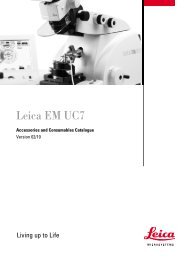Physical Principles of Electron Microscopy: An Introduction to TEM ...
Physical Principles of Electron Microscopy: An Introduction to TEM ...
Physical Principles of Electron Microscopy: An Introduction to TEM ...
Create successful ePaper yourself
Turn your PDF publications into a flip-book with our unique Google optimized e-Paper software.
<strong>Electron</strong> Optics 39<br />
As we said earlier, the overall speed v <strong>of</strong> an electron in a magnetic field<br />
remains constant, so the appearance <strong>of</strong> tangential and radial components <strong>of</strong><br />
velocity implies that vz must decrease, as depicted in Fig. 2-8c. This is in<br />
accordance with Eq. (2.6c), which predicts the existence <strong>of</strong> a third force Fz<br />
which is negative for z < 0 (because Br < 0) and therefore acts in the –z<br />
direction. After the electron passes the center <strong>of</strong> the lens, z , Br and Fz all<br />
become positive and vz increases back <strong>to</strong> its original value. The fact that the<br />
electron speed is constant contrasts with the case <strong>of</strong> the einzel electrostatic<br />
lens, where an electron slows down as it passes through the retarding field.<br />
We have seen that the radial component <strong>of</strong> magnetic induction Br plays<br />
an important part in electron focusing. If a long coil (solenoid) were used <strong>to</strong><br />
generate the field, this component would be present only in the fringing<br />
field at either end. (The uniform field inside the solenoid can focus electrons<br />
radiating from a point source but not a broad beam <strong>of</strong> electrons traveling<br />
parallel <strong>to</strong> its axis). So rather than using an extended magnetic field, we<br />
should make the field as short as possible. This can be done by partially<br />
enclosing the current-carrying coil by ferromagnetic material such as s<strong>of</strong>t<br />
iron, as shown in Fig. 2-9a. Due <strong>to</strong> its high permeability, the iron carries<br />
most <strong>of</strong> the magnetic flux lines. However, the magnetic circuit contains a<br />
gap filled with nonmagnetic material, so that flux lines appear within the<br />
internal bore <strong>of</strong> the lens. The magnetic field experienced by the electron<br />
beam can be increased and further concentrated by the use <strong>of</strong> ferromagnetic<br />
(s<strong>of</strong>t iron) polepieces <strong>of</strong> small internal diameter, as illustrated in Fig. 2-9b.<br />
These polepieces are machined <strong>to</strong> high precision <strong>to</strong> ensure that the magnetic<br />
field has the high degree <strong>of</strong> axial symmetry required for good focusing.<br />
Figure 2-9. (a) Use <strong>of</strong> ferromagnetic s<strong>of</strong>t iron <strong>to</strong> concentrate magnetic field within a small<br />
volume. (b) Use <strong>of</strong> ferromagnetic polepieces <strong>to</strong> further concentrate the field.



